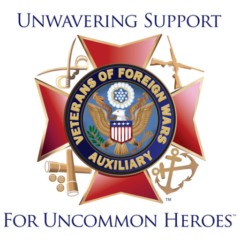Tanya Constant (360) 990-1508 Email monthly report form
Buddy Poppy proceeds represent no profit to any VFW unit. All money contributed by the public for Buddy Poppies is used for members of the Armed Forces, veterans’ welfare, or for the well-being of needy dependents, widows and orphans of veterans.
The Veterans of Foreign Wars of the United States was the first veterans organization to promote a nationally organized campaign for the annual distribution of poppies assembled by disabled and needy veterans.
The poppy movement was inspired by the poem “In Flanders Fields,” written by Col. John McCrae of the Canadian forces before the United States entered World War I. Distributing replicas of the original Flanders Poppy originated in some Allied countries immediately after the Armistice. No definite organized distribution of poppies on a nationwide scale was conducted in America until 1921, when the Franco-American Children’s League distributed poppies ostensibly for the benefit of children in the devastated areas of France and Belgium. Madame Guerin, who was recognized as “the poppy lady from France,” sought and received the cooperation of the VFW of the U.S. in early 1922, after the Franco-American Children’s League was dissolved. The VFW conducted a poppy campaign prior to Memorial Day 1922, using only poppies made in France. In the 1923 poppy campaign, due to difficulty and delay in getting poppies from France, the VFW used French poppies that were on hand, and the balance was provided by a firm in New York City manufacturing artificial flowers. During the 1923 campaign, the VFW evolved the idea which resulted in the VFW “Buddy”® Poppy fashioned by disabled and needy veterans who were paid for their work. This plan was formally presented for adoption to the 1923 Encampment at Norfolk, Virginia.
Immediately thereafter, the VFW Buddy Poppy factory was established in Pittsburgh, Pennsylvania, where all the VFW Buddy Poppies for the 1924 campaign were assembled by disabled veterans. Gen. Frank T. Hines, Director of the U.S. Veterans’ Bureau, endorsed the plan and pledged the cooperation of his department. All men employed in assembling Buddy Poppies for the 1924 campaign were sent to the VFW Poppy workshop by the Veterans’ Bureau regional manager in Pittsburgh. The designation Buddy Poppy, which originated with the men themselves, was adopted at that time. The VFW has made that trademark a guarantee that all poppies bearing that name and the VFW label are genuine products of the work of disabled and needy veterans. No other organization, firm or individual can make legal use of the name Buddy Poppy.
Following the 1924 campaign, a number of larger VFW Departments (states) believed it would stimulate local distribution if the poppies they used were assembled by disabled veterans in hospitals within their own jurisdiction. The 1924 VFW Encampment at Atlantic City granted this privilege, under the provision that all poppies would be produced according to specifications set forth by the National Buddy Poppy Department, and that all poppies would be assembled by disabled veterans in government hospitals and by needy veterans in workshops supervised by the VFW.
The VFW has steadfastly adhered to the policy of veteran assembled poppies. The VFW organized the first nationwide distribution of poppies by a veterans organization in May 1922. The poppy was adopted by the National Encampment in Seattle, during August of that year as the official memorial flower of the VFW.
In September 1920, the national convention of the American Legion held in Cleveland passed a resolution adopting the poppy as the official flower of that organization. However, at the third national convention of the American Legion held in Kansas City in October 1921, the American Legion repudiated the poppy and adopted the daisy as its official flower.
In October 1922, following the first nationwide distribution of poppies by the VFW during May of that year, the fourth national convention of the American Legion held in New Orleans in October adopted the following resolution: “Resolved, that the poppy is hereby declared to be the official American Legion flower, instead of the daisy, which was adopted by the 1921 convention of the American Legion.”
Following the successful poppy campaign conducted by the VFW in May 1922, the American Legion realized the financial possibilities of the poppy movement. In the spring of 1923, following the New Orleans encampment and one year after the first VFW Poppy campaign on a nationwide scale, the American Legion conducted its first poppy distribution using poppies supplied by a French manufacturer.
From the very beginning, the Buddy Poppy project of the VFW has received the endorsement and cooperation of the director of the Veterans Administration, and the support of administrators and medical officers of government hospitals. All presidents since Warren G. Harding (1921-23) have conveyed to the nation at large endorsement and recognition of this VFW effort.
Today, the VFW Buddy Poppies are assembled by disabled, needy and aging veterans in VA rehabilitation centers. The majority of proceeds derived from each campaign conducted by the VFW Posts and their Auxiliaries is retained locally to provide for veteran services and welfare. The minimal assessment (cost of Buddy Poppies) to the VFW units provides compensation to the veterans who assembled the poppies, provides financial assistance in maintaining state and national veterans’ rehabilitation and service programs, and partially supports the VFW National Home for Children, a community of children and families of veterans and active-duty military.
